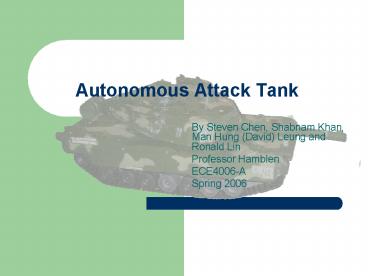Autonomous Attack Tank - PowerPoint PPT Presentation
1 / 19
Title:
Autonomous Attack Tank
Description:
The team feels that we are currently missing the big picture. ... We need to integrate and assimilate all our individual contributions into a working unit. ... – PowerPoint PPT presentation
Number of Views:19
Avg rating:3.0/5.0
Title: Autonomous Attack Tank
1
Autonomous Attack Tank
- By Steven Chen, Shabnam Khan, Man Hung (David)
Leung and Ronald Lin - Professor Hamblen
- ECE4006-A
- Spring 2006
2
Resolutions
- In order to speed up the pace of the project, the
team has decided to do the following - Focusing more time on the project and make up
lost time and landmarks that were supposed to be
achieved. - Moving resources to areas that are lacking
3
Pressing Issues
- The team feels that we are currently missing the
big picture. - We have completed much of the individual parts
including interfaces to parts but the overall
integration needs to be done. - We need to integrate and assimilate all our
individual contributions into a working unit. - The codes for input and output need to be
integrated into one running algorithm.
4
General Overview
- The proposed Gantt chart.
5
Overview
- Many of the individual tasks have been completed
as planned in the Gantt Chart. - All parts have been ordered.
- CMU camera was found to be malfunctioning.
- Team still waiting on the camera.
- Team plans to dedicate more time per week on the
project from now on to make up on the lost time. - Overall integration of individual parts into a
working unit needs to be done.
6
Parts Acquisition
- Ordered Parts
- Batteries for Altera Board and Motors
- New chargers
- H-bridges to drive motors
- 7 Sonar Sensors for detection
- Wheel rotation counter
7
Pulse-Width Modulator for Speed Control
- Written in VHDL
- Direction MSB of 8-bit speed value
- 0 forward, 1 backwards
- Continually increments counter until desired
speed is reach - Actual movement pulse variable set to 1
- H-bridge
- Input direction and speed
- Thermal override
8
Pulse Width Modulation Decoding (for SRF05 sensor)
- SRF05 Operating in Mode 1 Separate Trigger and
Echo
9
Code Specifics
- Max time out time is approximately 30 ms, clock
frequency is 100 Mhz - Implies we need to at least count up to 3,000,000
cycles 21.5 bits 22 bits on value line
10
Processes in Decoding
- Send pulse of 11 us every 100 ms
- Integer count up to 10,000,000 incremented every
clock - If integer lt 1,100 then high on control line
- Count up on rising clock edge when echo line high
- Write output to register on falling echo edge
11
Application for PWM Decoder
- All inputs to tank
- Interface
- Compass (I2C optional)
- Wheel Counter
- Sonar
12
Result
- PWM Decoding for Sonar Adaptable for Other
interfaces - VHDL coded PWM Decoder
- Clock, Reset, Pulse (echo line) Inputs
- Control line and Value (22 bits) outputs
13
Camera Development Summary
- Numerous problems encountered during the testing
phase of the CMU Camera - After exhaustive testing, CMU Camera was deemed
to be defective - New CMU camera in the process of being ordered
14
CMU Camera Testing
- Hooked CMU camera up to power supply and tested
using Senior Design lab PC - Unexpected results from initial tests
- Were able to connect to the camera using the
serial port - Camera did not respond to any commands beyond
outputting the version number - Failed to capture a frame using the JAVA
interface provided by the camera manufacturer
15
CMU Camera Testing cont.
- Additional attempts to put camera into demo mode
failed - Swapping out the camera portion of the CMU camera
with an identical camera failed to work - Conclusion faulty circuitry was on the main
board of the CMU camera, not the camera
daughterboard
16
CMU Camera Testing cont.
- Visual examination of the main board yielded no
obvious signs of burnt components or broken
components - Schematic of the CMU camera was consulted to for
further troubleshooting
17
CMU Camera Testing cont.
After analysis of the CMU camera schematic, and
various troubleshooting tests it was determined
that the PIC microcontroller chip or one of the
lines feeding into the PIC microcontroller chip
was defective.
18
CMU Camera Testing cont.
- Due to the extremely specialized nature of the
PIC chip, we were unable to find a replacement
for the chip - We concluded that a new CMU camera must be
ordered, or alternate implementations would have
to be sought
19
Questions?
- ?































